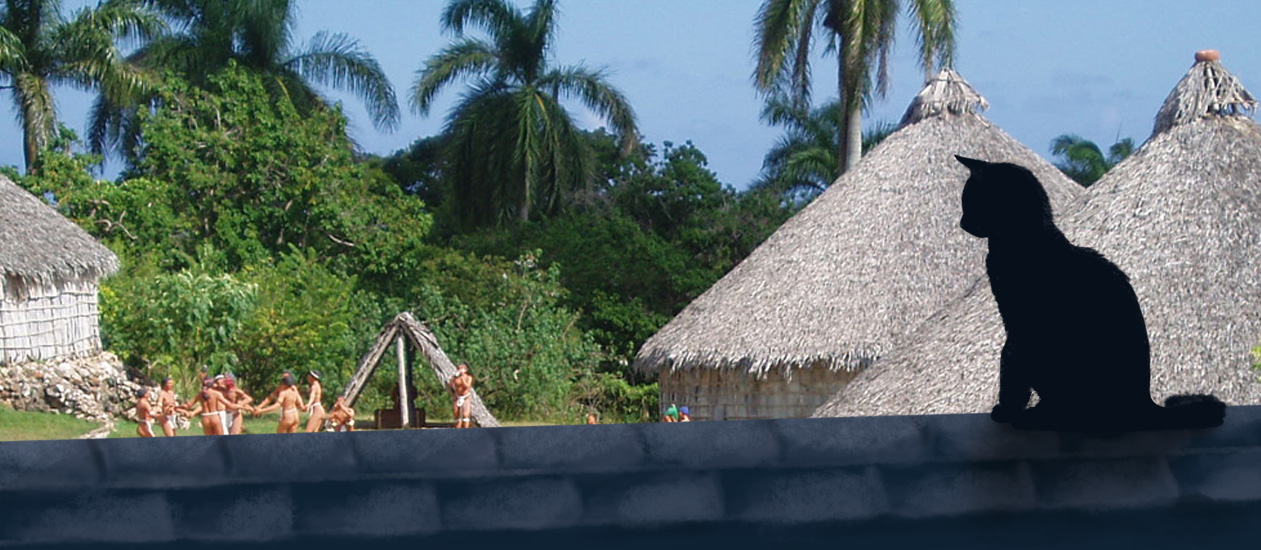Taíno
The Taíno are one of the indigenous peoples of the Altaynan Sea. They are, in fact, the source of the name after early Andalusi explorers recorded them as al-Taynu.
Taíno people were widespread throughout the northeastern islands in the early 16th century. They had their first contact with Europeans in 1498, when an Andalusi expedition, led by Ammaar el-Younan, landed in Albihama. El-Younan claimed the islands for Al-Andalus and began the process of colonization in the Altaynan.
While direct colonization on the mainland of the New World was resisted by the large confederacies with consolidated power, such as the Wabanaki and Haudenosaunee confederacies, the small islands of the Altaynan were unable to resist Europeans encroachment. The islands of the Altaynan were taken over by the Andalusi in the east and the Batavian Republic in the west.
By the end of the 16th century, all islands of the Altaynan were under foreign control. The Taíno were divided into those living under Batavian rule and those under the Andalusi. In the beginning, the settlers occupied urban areas along the coast while the Taíno lived inland, mostly left to live their traditional ways. As agricultural pursuits expanded, some Taíno came to work for low wages on the farms of settlers. Even more were forced into slavery to serve as manual labourers to upkeep the colonies.
The settlements gradually spread, pushing Taíno into more and more crowded corners of their islands. On the island of Sint Johannes, the local Taíno fought back against the Batavian settlers in 1585. The fighting lasted for 6 months, with Batavian soldiers struggling against the guerrilla tactics of the Taíno and their knowledge of the island. However, it ultimately ended in defeat for the Taíno, and most of the population was massacred.
In the 17th century, agriculture on the islands turned into the production of sugar. As sugar plantations grew and needed more and more workers, slavery expanded.
Andalusi Slavery
Slaves in the Andalusi Altaynan worked both in sugar plantations and in the homes of settlers. Since the beginning of Andalusi settlement, Taíno women were frequently taken as concubines, especially in the early years of the colonies when very few Andalusi women had come. This was the earliest form of slavery on the islands, and remains a common practice. Women are more likely to be sexual slaves or household slaves. Most men are field workers, although some are also taken to be eunuchs.
Andalusi laws on slavery are dependant on religion. Pagan slaves are afford no rights beyond a basic mandate that they be treated fairly, be given a break during the hottest part of the day, and be provided with food, shelter, and medicine. Masters are also expected to attempt to convert their slaves to Islam. Only slaves that have converted may eventually be freed, and are given more privileged positions. Some of these positions could be quite high, such as serving as secretaries to governors.
Only non-Muslims can be enslaved, although conversion to Islam does not automatically emancipate one. By the 18th century, almost all Taíno still living free had converted to Islam, and Andalusi slave holders relied exclusively on the children of slaves as a source of new labour. To distinguish between the enslaved and the free Taíno living in rural villages, most slaveholders branded their slaves. Local militias frequently raided Taíno villages to re-capture slaves who had escaped. They were often accused of capturing free men and women as well, but Taíno protests that they were not born slaves were never listened to.
Batavian Slavery
Slaves in the Batavian Altaynan were not as deeply melded with society. Slaves were used as workers, but never given positions of power as they were in Andalusi colonies. Batavians looked down upon the Andalusi for the practice of taking concubines or castrating men to make eunuchs, considering both practices barbaric. To the Andalusi, however, the Batavian method of raping a slave girl whenever one feels like it and then sending her back to the fields is true barbarism.
In the beginning, Batavian settlers relied on free labour for the fields and construction of towns. They kept separate from the Taíno natives, remaining along the coast and letting the indigenous people maintain their traditional lives inland. The sugar plantations that emerged int he 17th century required greater land and greater labour.
In 1634, a system of apartheid was implemented throughout the Batavian Altaynan. Under this system, all native people would be considered slaves, as would anyone with more than 50% indigenous blood. In the following years, Batavian landholders would regularly send parties into forest to round up new slaves whenever needed. The Taíno were seen as a natural resource, to be captured and enslaved whenever necessary. By 1660, there were no longer any free Taíno on Batavian islands and their villages were torn down to make room for more plantations.
Jamaica
The island of Jamaica was originally under Andalusi control, until it was taken by the Batavians in 1692. The free Taíno on Jamaica, who were marginalized but still free under the Andalusi system, fought back against the Batavians to avoid the apartheid system forcing all of them into slavery. They took advantage of the chaos of the regime change to stage a revolt, freeing as many slaves as they could in their push for freedom.
The uprising was successful, and they managed to force the Batavians off the island. Jamaica became, and remains, the only independent Taíno nation. The nation, however, struggles with the lack of trade from any European power, which refuses to recognize the upstart nation in fear of encouraging more revolutions among their own slaves. Their main ally is the United Nahua Republic, with whom they have positive relations and the promise of military backing in exchange for low tariffs on sugar.
Cover image:
by
Michal Zalewski


